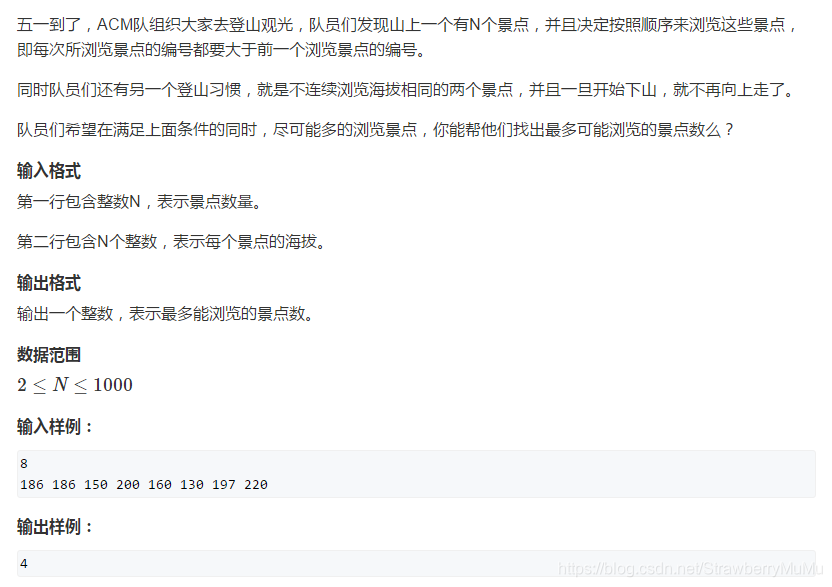AcWing 1014. 登山JAVA(最长单调子序列 单调栈)
本文共 1516 字,大约阅读时间需要 5 分钟。

时间复杂度:
O(nlogn)
//单调栈问题//分别计算从左向右和从右向左的最长上升子序列,分别存储到两个数组中import java.util.*; class Main{ static int n = 0, N = 1010; static int[] nums = new int[N]; static int[] left = new int[N], right = new int[N]; static int bs(int[] max, int len, int num){//找到从左到右第一个大于num的数字 int l = 0, r = len; while(l < r){ int mid = l + r >> 1;//+1防止mid不变造成死循环。 if(max[mid] < num)l = mid + 1; else r = mid; } return l; } public static void main(String[] args)throws Exception{ Scanner sc = new Scanner(System.in); int m = sc.nextInt(); for(int i = 1; i <= m; ++i)nums[i] = sc.nextInt(); int[] st = new int[N];//单调栈 int tt = -1; for(int i = 1; i <= m; ++i){ if(tt == -1)st[++tt] = nums[i]; if(tt >= 0 && st[tt] > nums[i]){ int index = bs(st, tt, nums[i]); st[index] = nums[i]; } if(st[tt] < nums[i])st[++tt] = nums[i]; left[i] = tt + 1; } tt = -1; for(int i = m; i >= 1; --i){ if(tt == -1)st[++tt] = nums[i]; if(tt >= 0 && st[tt] > nums[i]){ int index = bs(st, tt, nums[i]); st[index] = nums[i]; } if(st[tt] < nums[i])st[++tt] = nums[i]; right[i] = tt + 1; } int max = 0; for(int i = 1; i <= m; ++i){ max = Math.max(max, left[i] + right[i] - 1); } System.out.print(max); }}
转载地址:http://dfre.baihongyu.com/
你可能感兴趣的文章
nginx负载均衡
查看>>
Nginx负载均衡
查看>>
Nginx负载均衡与动静分离架构实现
查看>>
Nginx负载均衡和F5的区别---系统运维工作笔记001
查看>>
nginx负载均衡和反相代理的配置
查看>>
nginx负载均衡器处理session共享的几种方法(转)
查看>>
nginx负载均衡的5种策略
查看>>
nginx负载均衡的5种策略(转载)
查看>>
nginx负载均衡的五种算法
查看>>
Nginx负载均衡详解
查看>>
Nginx负载均衡(upstream)
查看>>
Vue中删除el-table当前行的方法
查看>>
nginx转发端口时与导致websocket不生效
查看>>
Nginx运维与实战(一)-Nginx不同场景使用方法
查看>>
Nginx运维与实战(二)-Https配置
查看>>
Nginx部署_mysql代理_redis代理_phoenix代理_xxljob代理_websocket代理_Nacos代理_内网穿透代理_多系统转发---记录021_大数据工作笔记0181
查看>>
nginx部署本地项目如何让异地公网访问?服务器端口映射配置!
查看>>
Nginx配置HTTPS服务
查看>>
Nginx配置https的一个误区(导致404错误)
查看>>
Nginx配置Https证书
查看>>